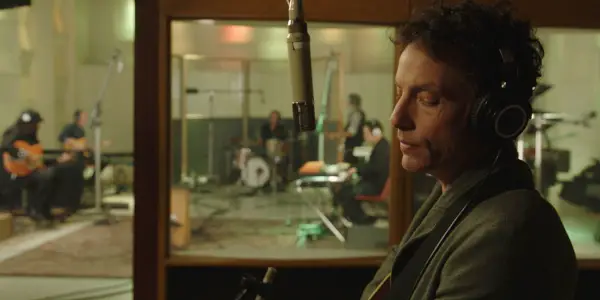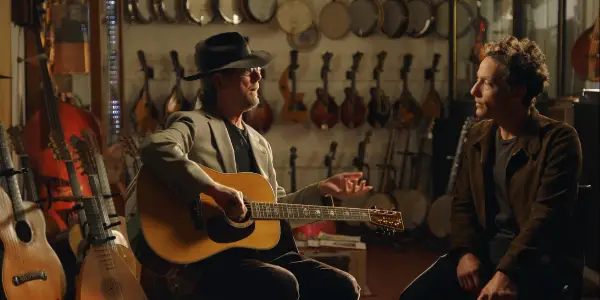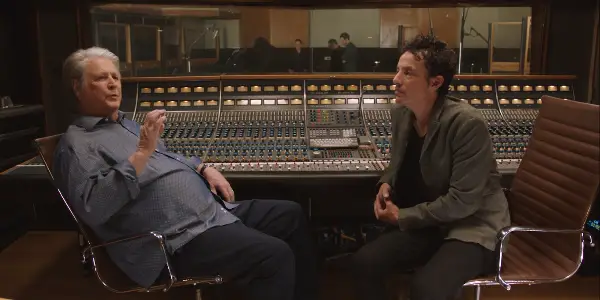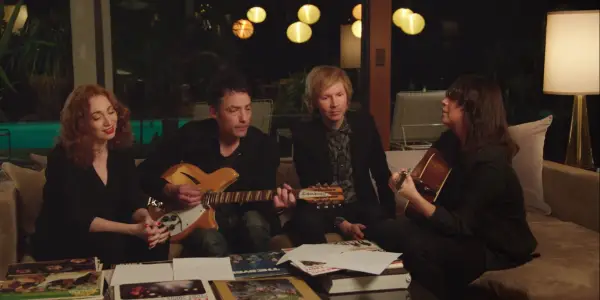ECHO IN THE CANYON: A Fitting Homage To The Epicenter Of The ’60s Rock Scene

Tynan loves nagging all his friends to watch classic movies…
The reverberations of “Turn! Turn! Turn!” are unmistakable. One could make the case it was the song that started it all. Because Echo in The Canyon is an ode to a time and place. Laurel Canyon, couched near the Sunset Strip in Los Angeles, would serendipitously become a hotbed of music throughout the ’60s and ’70s spawning a plethora of luminary talents. It was, at its best, a melting point of artistic expression and inspiration.
The poignant opening intro finds our guide Jakob Dylan alongside the late Tom Petty as the rocker and lifelong music fan examines a Rickenbacker guitar. While not necessarily integral to the sound we can trace back to Laurel Canyon, he was no less a part of that cultural moment – a diehard aficionado of the musical explosion that came in the aftermath of The Beatles’ ascension on The Ed Sullivan Show in February 1964. And Petty’s ties to the likes of George Harrison and Bob Dylan is not to be downplayed thanks to his own prominent career and the subsequent formation of the supergroup The Traveling Wilburys.
Like the staggering prolific soundtrack of The Wrecking Crew before it, Echo in the Canyon boasts its own mind-boggling catalogue of music to pull from. While the documentary doesn’t scrimp on musical rights, it supplements the originals with new renditions and attention is deferred to some less heralded tracks. Ultimately, it benefits from most if not all of its investments and subsequent digressions.
Origins of an Idea
Oddly enough, the entire venture was instigated by a viewing of a film. For anyone who has actually seen Jacques Demy’s Model Shop, it feels like one of the most relevant visual time capsule if we wanted to glean an understanding of Los Angeles in the late 1960s. Because it’s not so much focused around an intricate plot-line as it is content with drifting around the Sunset Strip and The Canyon.

It was this evocation leading music-lifers Andrew Slater and Jakob Dylan to begin ruminating on the idea to tackle the exorbitantly rich musical history of Laurel Canyon. Because, of course, it was these very same paths of the film that would become the meeting grounds of some of the most seminal musicians of the ’60s and ’70s.
Another helpful benchmark proved to be the 50th anniversary of The Byrds debut album, “Mr. Tambourine Man”, which is usually agreed upon as the true origins of folk rock – a strain of music that has admittedly become one of my personal favorites and has continually intrigued me over the recent years. I’ve even curated a playlist structured around this sub-genre indebted to bands like The Byrds, Buffalo Springfield, and certainly Bob Dylan and The Beatles. It gets overwhelming just beginning to list off all the names of artists so I’ll take them in stride organically instead of falling into this tempting trap.
Remembering a Magical Time in Music
It seems almost apropos that Jakob Dylan would be the interview and the glue, as it were, tying these stories together. Not only does he have deep-rooted connections to the industry and, no doubt, most of his subjects, but he looks so much like his father it’s uncanny. There’s an enigmatic thoughtfulness to him; it’s almost like the being of Bob Dylan himself is floating over the picture giving his implicit blessing. Because he, as much as anyone, was integral to this whole movement even if it was more based on his records than proximity to The Canyon itself.
He was the one who jumpstarted The Byrds (they covered many of his tunes including “Mr. Tambourine Man”) and Dylan pushed The Beatles to take their music into a more mature, introspective realm. But that’s enough skirting around the obvious. Let’s just put it out there. This movie is stacked with some greats.
My eyes bulged out of my sockets by the sheer number of talents the younger Dylan was able to wrangle together for one-on-one interviews. The rhythms of the exploration are relatively straightforward. Music, stills, and stock footage are interspersed with contemporary interviews. Dylan seems all but content to sit back and let the colorful personalities and artistic voices around him take center stage and obligingly, they do.
It’s nothing altogether flashy but the presentation is clean and appealing doing its best not to distract too much from the actual points of interest. As with any project where you’re gathering such titans of the industry, the documentary is ripe with the kind of tidbits and insider recollections music junkies will eat up if they haven’t heard them already.
One of the ideas that becomes heavily apparent surrounding the magic of Laurel Canyon is not only how collaborative it was but how you had this transatlantic cross-pollination. Everyone was taking inspiration from everyone else and trying to top each other to create the best tracks they could.

Surely The Beatles were at the forefront of all this. Ringo talks fondly about The Byrds and albums that really turned them on. Then, The Rolling Stones are mentioned in passing along with Eric Clapton’s Cream with the masterful guitarist suggesting the supergroup was inspired by the musical philosophy of The Beach Boys. You have Graham Nash also being interviewed – another transplant from England trading his success with The Hollies for a fruitful collaboration with David Crosby and Stephen Stills.
But if we are to consider The Byrds a fitting starting point, it is founding member Roger McGuinn’s recollections that must really take center stage. He became the initial driving force behind The Byrds’ integrated sound, bringing Beatles rock chord progressions to the thoughtful lyricism of folk music.
Add McGuinn’s virtuoso guitar playing on his 12-string Rickenbacker and you had the jingle jangle that would come to define their sound. He shares memories of meeting John and Paul on their first trip to England and inspiring George’s playing on Rubber Soul. Meanwhile, Crosby is ever a colorful, opinionated figure. Among other things, he takes the blame for being kicked out of The Byrds. Though he didn’t do too badly for himself afterward…
The Talent: Then and Now
If The Byrds and The Beatles are counted as the tip of the spear then certainly they didn’t function alone. If anything, this documentary is a constant reminder of how many groups came into being. An important distinction is the singer-songwriter generation of the 1970s who would come as an almost reactionary force. For now, it was all about bands.
We had The Mamas & The Papas and the last remaining member Michelle Phillips recall their first day auditioning for Lou Adler with a couple of dead ringers like “California Dreamin” and “Monday, Monday” to show off. These were just a couple of the tunes that made them perennial mainstays of The California Sound.
As a perfect segue, Phillips shares memories of living down the street from Brian Wilson and entering his house one day to find the living full to the brim with sand and a piano. That was all. Neurosis aside, there’s no downplaying Brian’s genius because, of course, his output at this very juncture in time would ultimately come to fruition as Pet Sounds – considered by many one of the finest records of all-time.

In his own interview, Wilson recollects how his mind was blown by “Rubber Soul“. He countered with “Pet Sounds”. And not to be outdone The Beatles came back with “Srgt. Pepper”. Another delightful interlude recounts how he literally pieced together his crowning achievement, “Good Vibrations,” together across all the studios in L.A. Because each one had a specialty he harnessed for his complex arrangement stitching together the instrumentation and vocals in an epic composition.
The final group to get substantial time in the spotlight, rightfully so, is Buffalo Springfield. Founding members Stephen Stills and Neil Young hit it off from the outset with their overlapping tastes in rock n’ roll and folk music. The memories are supplemented by footage of the band’s dual performance of “For What It’s Worth” and “Mr. Soul”.
However, for Dylan’s purposes, he takes Stills’ slightly deeper cut “Questions” to reimagine in the 21st century. He calls on quite the pair to aid him in the new rendition. Stills’ subsequent dueling guitar solo with Eric Clapton, spliced together in the studio, is one enjoyable moment that all but leaves one grinning with relish.
Not surprisingly, the least engaging portions are the live renditions and studio sessions with updated sounds and instrumentation provided by Dylan and his friends. Listening to Dylan sing his version of “Go Where You Wanna Go” or “I Just Wasn’t Made for These Times” obviously doesn’t measure up to their predecessors nor are they meant to.
He is not armed with the buoyancy or harmonies that made both those groups such a joy to listen to. Instead, coupled with the collaboration of such noteworthy performers as Regina Spektor, Norah Jones, and Beck, he comes at the material with a certain unadorned reverence.

The best compliment is the fact the soundtrack sheds some light on off-center songs like “The Bells of Rhymney,” “In My Room,” and “Expecting to Fly”. In one of Stephen Stills’ own rueful reminiscences, this latter song was Neil Young’s own coded warning he was quitting the band.
Of course, it did happen and Young did pretty well for himself going solo. Fittingly, he makes his only appearance in the documentary jamming away over the credits as one final callback. It’s a signifier of all that was coming ahead and simultaneously provides an open-ended call for someone else to document the rest of this evolving narrative.
Echo in the Canyon: Final Thoughts
My only real qualm is that with the vastness of the territory available to cover, you only reach the cusp of the music scene. Just to be clear, this is hardly the fault of the documentary itself. Creative decisions must be made.
It could take you in so many directions. There’s a stray mention of The Whisky A Go Go or The Troubadour here. Carole King is mentioned in passing there. And we don’t even get to Joni Mitchell, The Eagles, or Crosby, Stills, & Nash since they all came into prominence at the end of the ’60s. But with or without documentation, we have the songs to speak for themselves and that is enough.
It allows Echo In The Canyon to be a fitting accompaniment without feeling like it has to be a definitive, all-encompassing statement on Laurel Canyon. Those kind of expectations are admittedly preposterous. What it might do is trigger some agreeable memories in some baby boomers while reminding younger generations just how vibrant and timeless a lot of this music still remains today.
Maybe some of them will reexamine records like “Turn! Turn! Turn!”, “The Best of Buffalo Springfield”, and “Pet Sounds”. Brian Wilson being equated to Mozart is just about all the provocation you need. In fact, the word “timeless” probably gets bandied about far too liberally but surely, in this case, it remains true. Because, above all else, Echo in The Canyon reminds us what music is all about. It’s communal. That doesn’t change.
What do you think made the music coming out of Laurel Canyon stand the test of time? Are you familiar with bands like The Byrds and Buffalo Springfield? Let us know in the comments below!
Watch Echo in the Canyon
Does content like this matter to you?
Become a Member and support film journalism. Unlock access to all of Film Inquiry`s great articles. Join a community of like-minded readers who are passionate about cinema - get access to our private members Network, give back to independent filmmakers, and more.
Tynan loves nagging all his friends to watch classic movies with him. Follow his frequent musings at Film Inquiry and on his blog 4 Star Films. Soli Deo Gloria.













